Financial Decision Making
VerifiedAdded on 2023/01/06
|14
|3895
|48
AI Summary
This document discusses the role and functions of the accounting and finance department in Skanska plc. It also evaluates the organization's performance using key ratios such as the current ratio, net profit margin, and return on capital employed. The document provides insights into financial decision making and its importance in achieving organizational goals.
Contribute Materials
Your contribution can guide someone’s learning journey. Share your
documents today.

Financial Decision
Making
Making
Secure Best Marks with AI Grader
Need help grading? Try our AI Grader for instant feedback on your assignments.

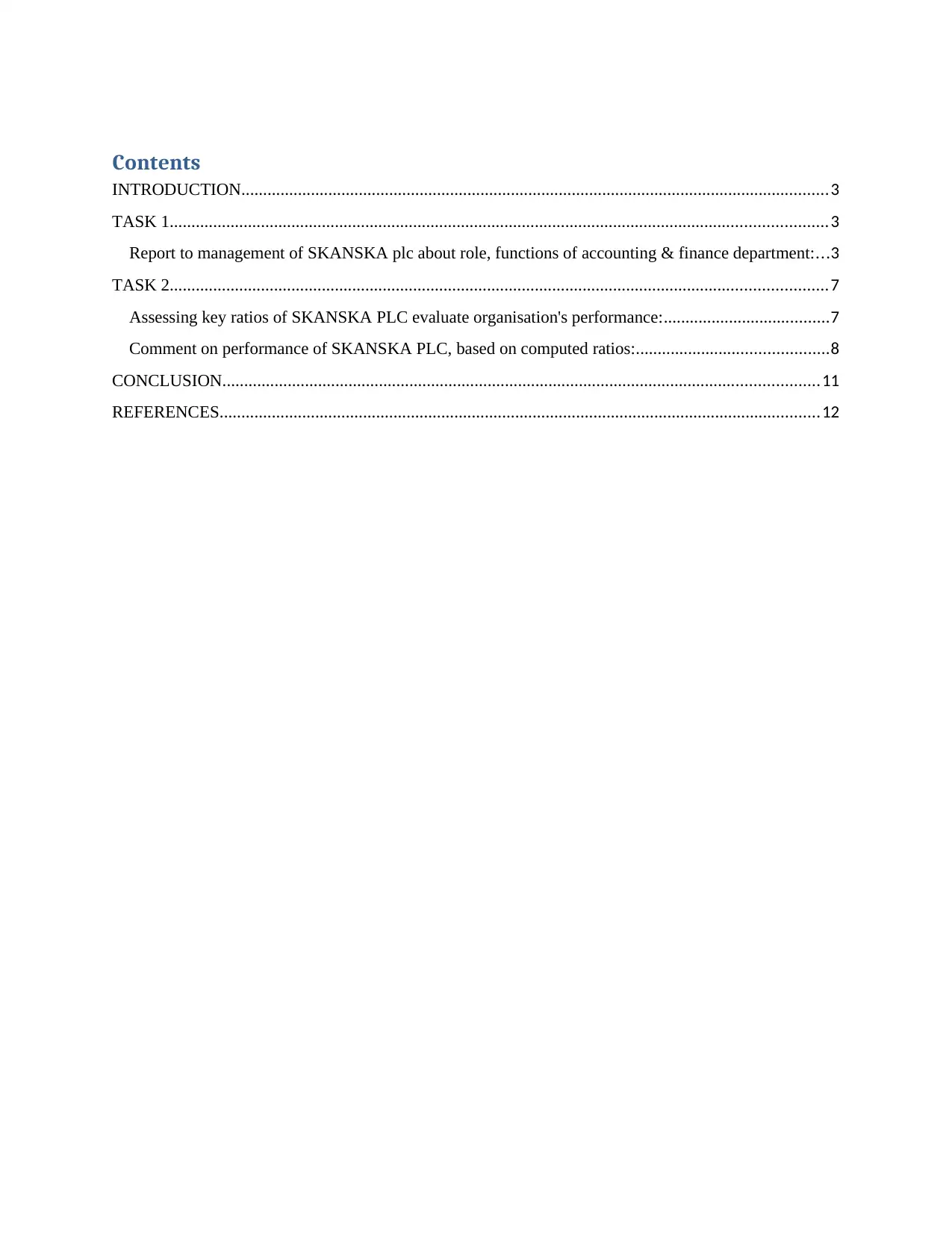
Contents
INTRODUCTION.......................................................................................................................................3
TASK 1.......................................................................................................................................................3
Report to management of SKANSKA plc about role, functions of accounting & finance department:...3
TASK 2.......................................................................................................................................................7
Assessing key ratios of SKANSKA PLC evaluate organisation's performance:......................................7
Comment on performance of SKANSKA PLC, based on computed ratios:............................................8
CONCLUSION.........................................................................................................................................11
REFERENCES..........................................................................................................................................12
INTRODUCTION.......................................................................................................................................3
TASK 1.......................................................................................................................................................3
Report to management of SKANSKA plc about role, functions of accounting & finance department:...3
TASK 2.......................................................................................................................................................7
Assessing key ratios of SKANSKA PLC evaluate organisation's performance:......................................7
Comment on performance of SKANSKA PLC, based on computed ratios:............................................8
CONCLUSION.........................................................................................................................................11
REFERENCES..........................................................................................................................................12
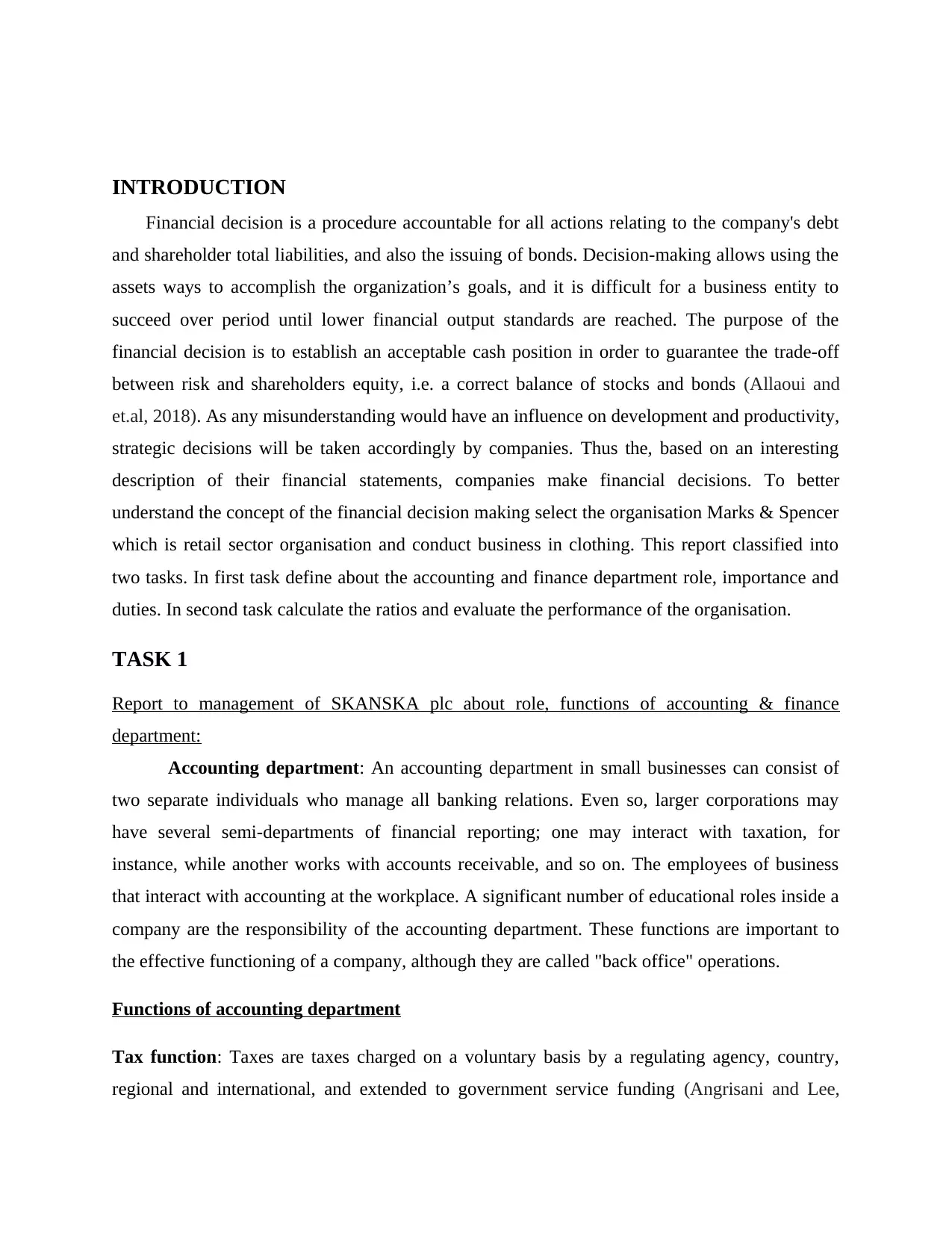
INTRODUCTION
Financial decision is a procedure accountable for all actions relating to the company's debt
and shareholder total liabilities, and also the issuing of bonds. Decision-making allows using the
assets ways to accomplish the organization’s goals, and it is difficult for a business entity to
succeed over period until lower financial output standards are reached. The purpose of the
financial decision is to establish an acceptable cash position in order to guarantee the trade-off
between risk and shareholders equity, i.e. a correct balance of stocks and bonds (Allaoui and
et.al, 2018). As any misunderstanding would have an influence on development and productivity,
strategic decisions will be taken accordingly by companies. Thus the, based on an interesting
description of their financial statements, companies make financial decisions. To better
understand the concept of the financial decision making select the organisation Marks & Spencer
which is retail sector organisation and conduct business in clothing. This report classified into
two tasks. In first task define about the accounting and finance department role, importance and
duties. In second task calculate the ratios and evaluate the performance of the organisation.
TASK 1
Report to management of SKANSKA plc about role, functions of accounting & finance
department:
Accounting department: An accounting department in small businesses can consist of
two separate individuals who manage all banking relations. Even so, larger corporations may
have several semi-departments of financial reporting; one may interact with taxation, for
instance, while another works with accounts receivable, and so on. The employees of business
that interact with accounting at the workplace. A significant number of educational roles inside a
company are the responsibility of the accounting department. These functions are important to
the effective functioning of a company, although they are called "back office" operations.
Functions of accounting department
Tax function: Taxes are taxes charged on a voluntary basis by a regulating agency, country,
regional and international, and extended to government service funding (Angrisani and Lee,
Financial decision is a procedure accountable for all actions relating to the company's debt
and shareholder total liabilities, and also the issuing of bonds. Decision-making allows using the
assets ways to accomplish the organization’s goals, and it is difficult for a business entity to
succeed over period until lower financial output standards are reached. The purpose of the
financial decision is to establish an acceptable cash position in order to guarantee the trade-off
between risk and shareholders equity, i.e. a correct balance of stocks and bonds (Allaoui and
et.al, 2018). As any misunderstanding would have an influence on development and productivity,
strategic decisions will be taken accordingly by companies. Thus the, based on an interesting
description of their financial statements, companies make financial decisions. To better
understand the concept of the financial decision making select the organisation Marks & Spencer
which is retail sector organisation and conduct business in clothing. This report classified into
two tasks. In first task define about the accounting and finance department role, importance and
duties. In second task calculate the ratios and evaluate the performance of the organisation.
TASK 1
Report to management of SKANSKA plc about role, functions of accounting & finance
department:
Accounting department: An accounting department in small businesses can consist of
two separate individuals who manage all banking relations. Even so, larger corporations may
have several semi-departments of financial reporting; one may interact with taxation, for
instance, while another works with accounts receivable, and so on. The employees of business
that interact with accounting at the workplace. A significant number of educational roles inside a
company are the responsibility of the accounting department. These functions are important to
the effective functioning of a company, although they are called "back office" operations.
Functions of accounting department
Tax function: Taxes are taxes charged on a voluntary basis by a regulating agency, country,
regional and international, and extended to government service funding (Angrisani and Lee,
Secure Best Marks with AI Grader
Need help grading? Try our AI Grader for instant feedback on your assignments.
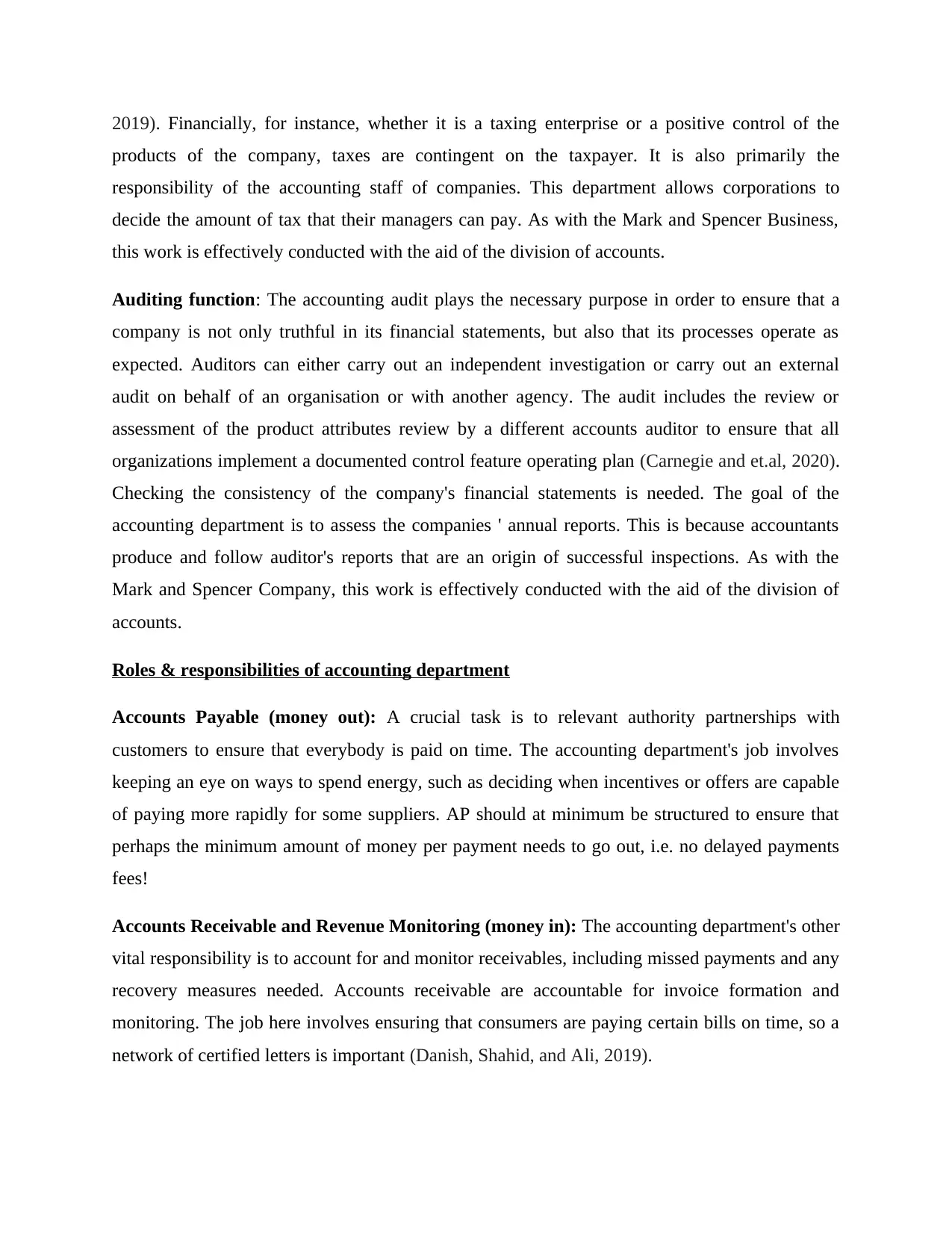
2019). Financially, for instance, whether it is a taxing enterprise or a positive control of the
products of the company, taxes are contingent on the taxpayer. It is also primarily the
responsibility of the accounting staff of companies. This department allows corporations to
decide the amount of tax that their managers can pay. As with the Mark and Spencer Business,
this work is effectively conducted with the aid of the division of accounts.
Auditing function: The accounting audit plays the necessary purpose in order to ensure that a
company is not only truthful in its financial statements, but also that its processes operate as
expected. Auditors can either carry out an independent investigation or carry out an external
audit on behalf of an organisation or with another agency. The audit includes the review or
assessment of the product attributes review by a different accounts auditor to ensure that all
organizations implement a documented control feature operating plan (Carnegie and et.al, 2020).
Checking the consistency of the company's financial statements is needed. The goal of the
accounting department is to assess the companies ' annual reports. This is because accountants
produce and follow auditor's reports that are an origin of successful inspections. As with the
Mark and Spencer Company, this work is effectively conducted with the aid of the division of
accounts.
Roles & responsibilities of accounting department
Accounts Payable (money out): A crucial task is to relevant authority partnerships with
customers to ensure that everybody is paid on time. The accounting department's job involves
keeping an eye on ways to spend energy, such as deciding when incentives or offers are capable
of paying more rapidly for some suppliers. AP should at minimum be structured to ensure that
perhaps the minimum amount of money per payment needs to go out, i.e. no delayed payments
fees!
Accounts Receivable and Revenue Monitoring (money in): The accounting department's other
vital responsibility is to account for and monitor receivables, including missed payments and any
recovery measures needed. Accounts receivable are accountable for invoice formation and
monitoring. The job here involves ensuring that consumers are paying certain bills on time, so a
network of certified letters is important (Danish, Shahid, and Ali, 2019).
products of the company, taxes are contingent on the taxpayer. It is also primarily the
responsibility of the accounting staff of companies. This department allows corporations to
decide the amount of tax that their managers can pay. As with the Mark and Spencer Business,
this work is effectively conducted with the aid of the division of accounts.
Auditing function: The accounting audit plays the necessary purpose in order to ensure that a
company is not only truthful in its financial statements, but also that its processes operate as
expected. Auditors can either carry out an independent investigation or carry out an external
audit on behalf of an organisation or with another agency. The audit includes the review or
assessment of the product attributes review by a different accounts auditor to ensure that all
organizations implement a documented control feature operating plan (Carnegie and et.al, 2020).
Checking the consistency of the company's financial statements is needed. The goal of the
accounting department is to assess the companies ' annual reports. This is because accountants
produce and follow auditor's reports that are an origin of successful inspections. As with the
Mark and Spencer Company, this work is effectively conducted with the aid of the division of
accounts.
Roles & responsibilities of accounting department
Accounts Payable (money out): A crucial task is to relevant authority partnerships with
customers to ensure that everybody is paid on time. The accounting department's job involves
keeping an eye on ways to spend energy, such as deciding when incentives or offers are capable
of paying more rapidly for some suppliers. AP should at minimum be structured to ensure that
perhaps the minimum amount of money per payment needs to go out, i.e. no delayed payments
fees!
Accounts Receivable and Revenue Monitoring (money in): The accounting department's other
vital responsibility is to account for and monitor receivables, including missed payments and any
recovery measures needed. Accounts receivable are accountable for invoice formation and
monitoring. The job here involves ensuring that consumers are paying certain bills on time, so a
network of certified letters is important (Danish, Shahid, and Ali, 2019).
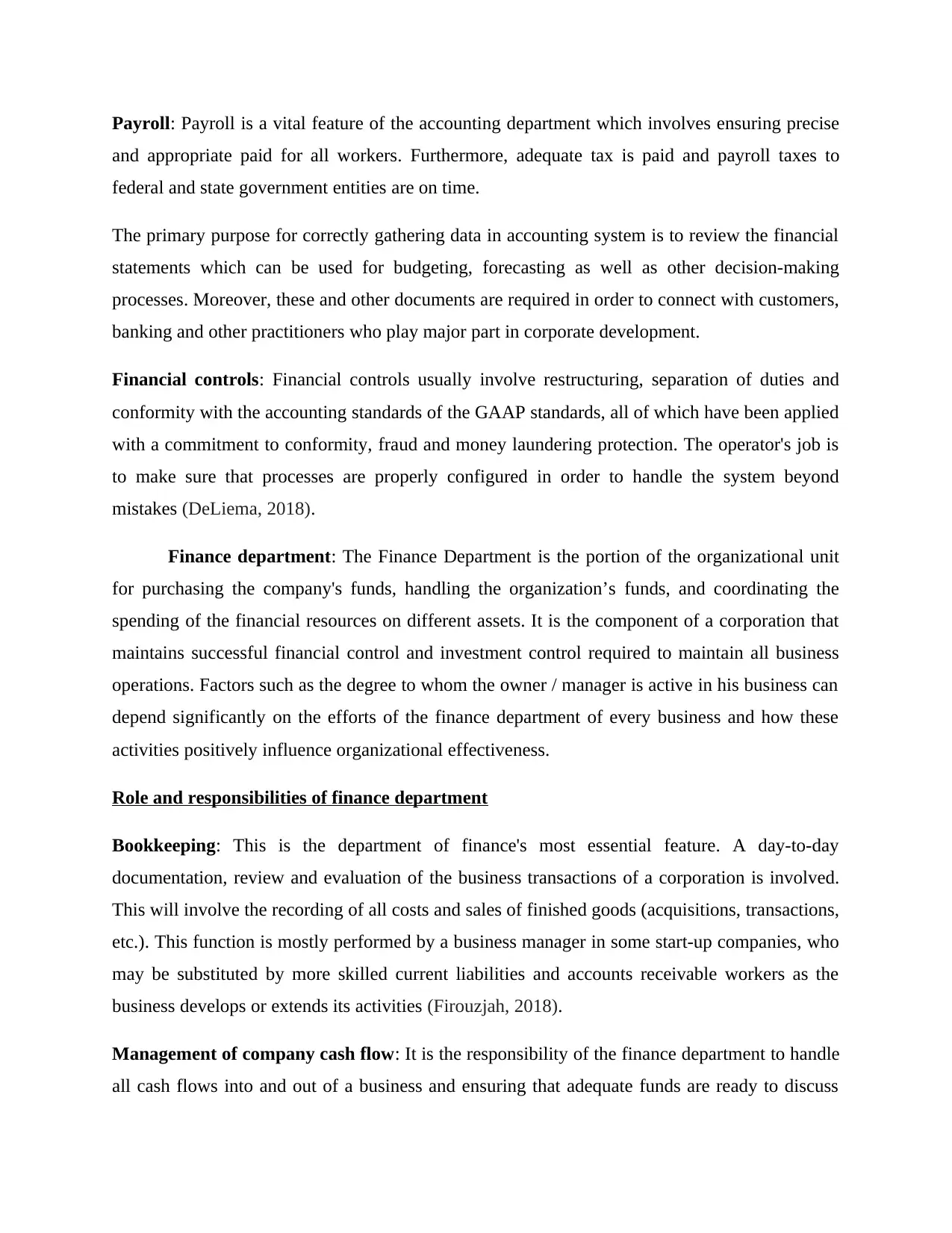
Payroll: Payroll is a vital feature of the accounting department which involves ensuring precise
and appropriate paid for all workers. Furthermore, adequate tax is paid and payroll taxes to
federal and state government entities are on time.
The primary purpose for correctly gathering data in accounting system is to review the financial
statements which can be used for budgeting, forecasting as well as other decision-making
processes. Moreover, these and other documents are required in order to connect with customers,
banking and other practitioners who play major part in corporate development.
Financial controls: Financial controls usually involve restructuring, separation of duties and
conformity with the accounting standards of the GAAP standards, all of which have been applied
with a commitment to conformity, fraud and money laundering protection. The operator's job is
to make sure that processes are properly configured in order to handle the system beyond
mistakes (DeLiema, 2018).
Finance department: The Finance Department is the portion of the organizational unit
for purchasing the company's funds, handling the organization’s funds, and coordinating the
spending of the financial resources on different assets. It is the component of a corporation that
maintains successful financial control and investment control required to maintain all business
operations. Factors such as the degree to whom the owner / manager is active in his business can
depend significantly on the efforts of the finance department of every business and how these
activities positively influence organizational effectiveness.
Role and responsibilities of finance department
Bookkeeping: This is the department of finance's most essential feature. A day-to-day
documentation, review and evaluation of the business transactions of a corporation is involved.
This will involve the recording of all costs and sales of finished goods (acquisitions, transactions,
etc.). This function is mostly performed by a business manager in some start-up companies, who
may be substituted by more skilled current liabilities and accounts receivable workers as the
business develops or extends its activities (Firouzjah, 2018).
Management of company cash flow: It is the responsibility of the finance department to handle
all cash flows into and out of a business and ensuring that adequate funds are ready to discuss
and appropriate paid for all workers. Furthermore, adequate tax is paid and payroll taxes to
federal and state government entities are on time.
The primary purpose for correctly gathering data in accounting system is to review the financial
statements which can be used for budgeting, forecasting as well as other decision-making
processes. Moreover, these and other documents are required in order to connect with customers,
banking and other practitioners who play major part in corporate development.
Financial controls: Financial controls usually involve restructuring, separation of duties and
conformity with the accounting standards of the GAAP standards, all of which have been applied
with a commitment to conformity, fraud and money laundering protection. The operator's job is
to make sure that processes are properly configured in order to handle the system beyond
mistakes (DeLiema, 2018).
Finance department: The Finance Department is the portion of the organizational unit
for purchasing the company's funds, handling the organization’s funds, and coordinating the
spending of the financial resources on different assets. It is the component of a corporation that
maintains successful financial control and investment control required to maintain all business
operations. Factors such as the degree to whom the owner / manager is active in his business can
depend significantly on the efforts of the finance department of every business and how these
activities positively influence organizational effectiveness.
Role and responsibilities of finance department
Bookkeeping: This is the department of finance's most essential feature. A day-to-day
documentation, review and evaluation of the business transactions of a corporation is involved.
This will involve the recording of all costs and sales of finished goods (acquisitions, transactions,
etc.). This function is mostly performed by a business manager in some start-up companies, who
may be substituted by more skilled current liabilities and accounts receivable workers as the
business develops or extends its activities (Firouzjah, 2018).
Management of company cash flow: It is the responsibility of the finance department to handle
all cash flows into and out of a business and ensuring that adequate funds are ready to discuss
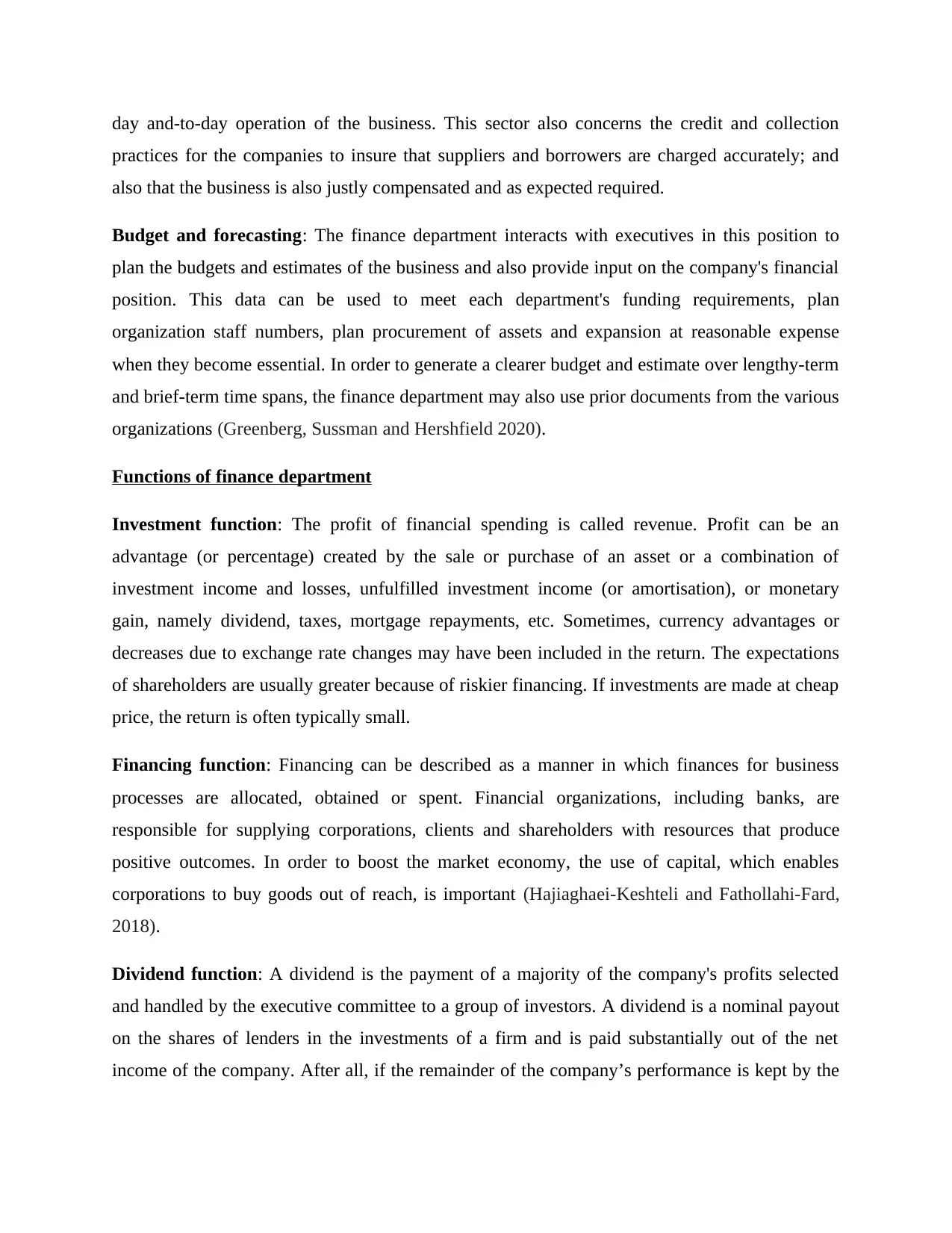
day and-to-day operation of the business. This sector also concerns the credit and collection
practices for the companies to insure that suppliers and borrowers are charged accurately; and
also that the business is also justly compensated and as expected required.
Budget and forecasting: The finance department interacts with executives in this position to
plan the budgets and estimates of the business and also provide input on the company's financial
position. This data can be used to meet each department's funding requirements, plan
organization staff numbers, plan procurement of assets and expansion at reasonable expense
when they become essential. In order to generate a clearer budget and estimate over lengthy-term
and brief-term time spans, the finance department may also use prior documents from the various
organizations (Greenberg, Sussman and Hershfield 2020).
Functions of finance department
Investment function: The profit of financial spending is called revenue. Profit can be an
advantage (or percentage) created by the sale or purchase of an asset or a combination of
investment income and losses, unfulfilled investment income (or amortisation), or monetary
gain, namely dividend, taxes, mortgage repayments, etc. Sometimes, currency advantages or
decreases due to exchange rate changes may have been included in the return. The expectations
of shareholders are usually greater because of riskier financing. If investments are made at cheap
price, the return is often typically small.
Financing function: Financing can be described as a manner in which finances for business
processes are allocated, obtained or spent. Financial organizations, including banks, are
responsible for supplying corporations, clients and shareholders with resources that produce
positive outcomes. In order to boost the market economy, the use of capital, which enables
corporations to buy goods out of reach, is important (Hajiaghaei-Keshteli and Fathollahi-Fard,
2018).
Dividend function: A dividend is the payment of a majority of the company's profits selected
and handled by the executive committee to a group of investors. A dividend is a nominal payout
on the shares of lenders in the investments of a firm and is paid substantially out of the net
income of the company. After all, if the remainder of the company’s performance is kept by the
practices for the companies to insure that suppliers and borrowers are charged accurately; and
also that the business is also justly compensated and as expected required.
Budget and forecasting: The finance department interacts with executives in this position to
plan the budgets and estimates of the business and also provide input on the company's financial
position. This data can be used to meet each department's funding requirements, plan
organization staff numbers, plan procurement of assets and expansion at reasonable expense
when they become essential. In order to generate a clearer budget and estimate over lengthy-term
and brief-term time spans, the finance department may also use prior documents from the various
organizations (Greenberg, Sussman and Hershfield 2020).
Functions of finance department
Investment function: The profit of financial spending is called revenue. Profit can be an
advantage (or percentage) created by the sale or purchase of an asset or a combination of
investment income and losses, unfulfilled investment income (or amortisation), or monetary
gain, namely dividend, taxes, mortgage repayments, etc. Sometimes, currency advantages or
decreases due to exchange rate changes may have been included in the return. The expectations
of shareholders are usually greater because of riskier financing. If investments are made at cheap
price, the return is often typically small.
Financing function: Financing can be described as a manner in which finances for business
processes are allocated, obtained or spent. Financial organizations, including banks, are
responsible for supplying corporations, clients and shareholders with resources that produce
positive outcomes. In order to boost the market economy, the use of capital, which enables
corporations to buy goods out of reach, is important (Hajiaghaei-Keshteli and Fathollahi-Fard,
2018).
Dividend function: A dividend is the payment of a majority of the company's profits selected
and handled by the executive committee to a group of investors. A dividend is a nominal payout
on the shares of lenders in the investments of a firm and is paid substantially out of the net
income of the company. After all, if the remainder of the company’s performance is kept by the
Paraphrase This Document
Need a fresh take? Get an instant paraphrase of this document with our AI Paraphraser
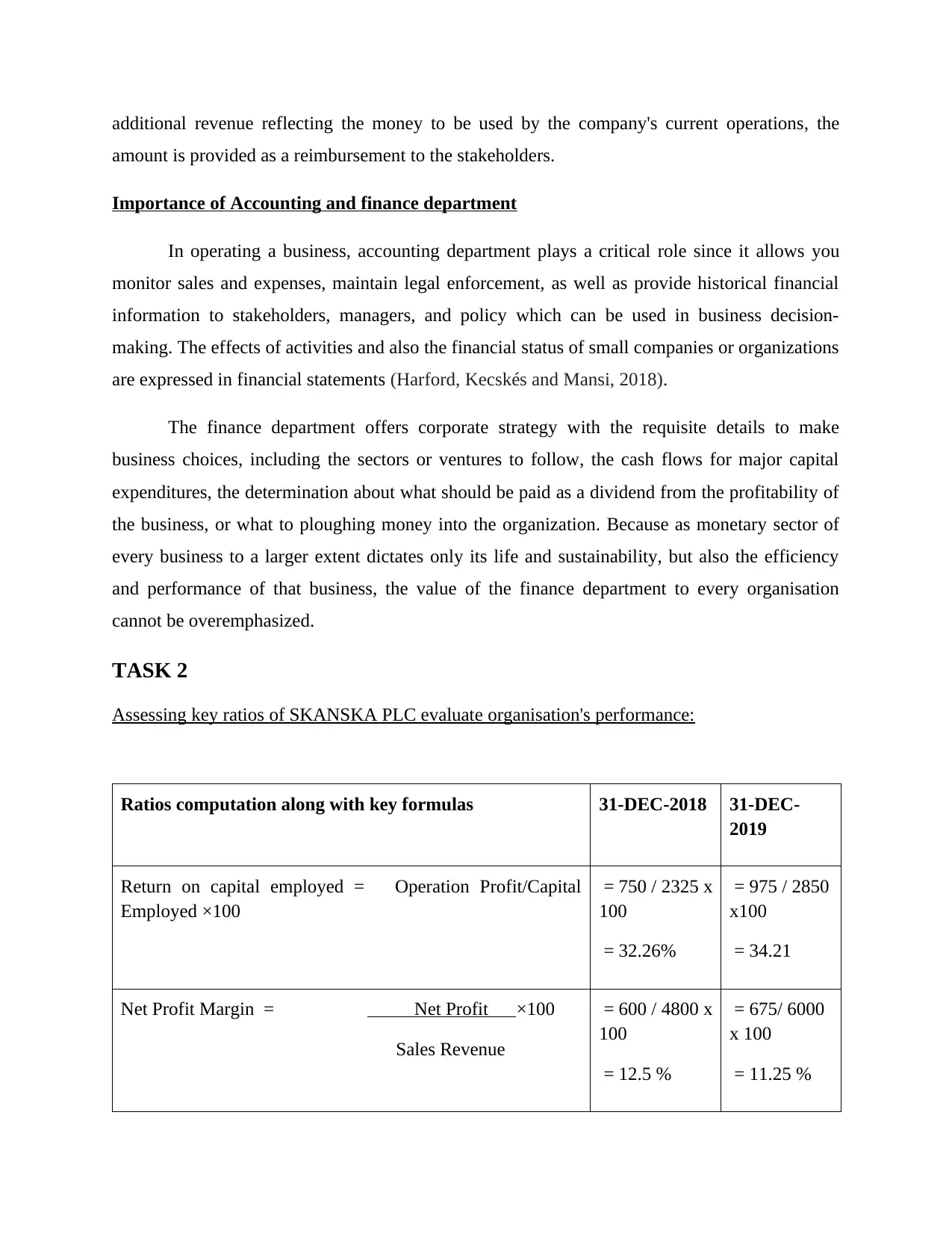
additional revenue reflecting the money to be used by the company's current operations, the
amount is provided as a reimbursement to the stakeholders.
Importance of Accounting and finance department
In operating a business, accounting department plays a critical role since it allows you
monitor sales and expenses, maintain legal enforcement, as well as provide historical financial
information to stakeholders, managers, and policy which can be used in business decision-
making. The effects of activities and also the financial status of small companies or organizations
are expressed in financial statements (Harford, Kecskés and Mansi, 2018).
The finance department offers corporate strategy with the requisite details to make
business choices, including the sectors or ventures to follow, the cash flows for major capital
expenditures, the determination about what should be paid as a dividend from the profitability of
the business, or what to ploughing money into the organization. Because as monetary sector of
every business to a larger extent dictates only its life and sustainability, but also the efficiency
and performance of that business, the value of the finance department to every organisation
cannot be overemphasized.
TASK 2
Assessing key ratios of SKANSKA PLC evaluate organisation's performance:
Ratios computation along with key formulas 31-DEC-2018 31-DEC-
2019
Return on capital employed = Operation Profit/Capital
Employed ×100
= 750 / 2325 x
100
= 32.26%
= 975 / 2850
x100
= 34.21
Net Profit Margin = Net Profit ×100
Sales Revenue
= 600 / 4800 x
100
= 12.5 %
= 675/ 6000
x 100
= 11.25 %
amount is provided as a reimbursement to the stakeholders.
Importance of Accounting and finance department
In operating a business, accounting department plays a critical role since it allows you
monitor sales and expenses, maintain legal enforcement, as well as provide historical financial
information to stakeholders, managers, and policy which can be used in business decision-
making. The effects of activities and also the financial status of small companies or organizations
are expressed in financial statements (Harford, Kecskés and Mansi, 2018).
The finance department offers corporate strategy with the requisite details to make
business choices, including the sectors or ventures to follow, the cash flows for major capital
expenditures, the determination about what should be paid as a dividend from the profitability of
the business, or what to ploughing money into the organization. Because as monetary sector of
every business to a larger extent dictates only its life and sustainability, but also the efficiency
and performance of that business, the value of the finance department to every organisation
cannot be overemphasized.
TASK 2
Assessing key ratios of SKANSKA PLC evaluate organisation's performance:
Ratios computation along with key formulas 31-DEC-2018 31-DEC-
2019
Return on capital employed = Operation Profit/Capital
Employed ×100
= 750 / 2325 x
100
= 32.26%
= 975 / 2850
x100
= 34.21
Net Profit Margin = Net Profit ×100
Sales Revenue
= 600 / 4800 x
100
= 12.5 %
= 675/ 6000
x 100
= 11.25 %
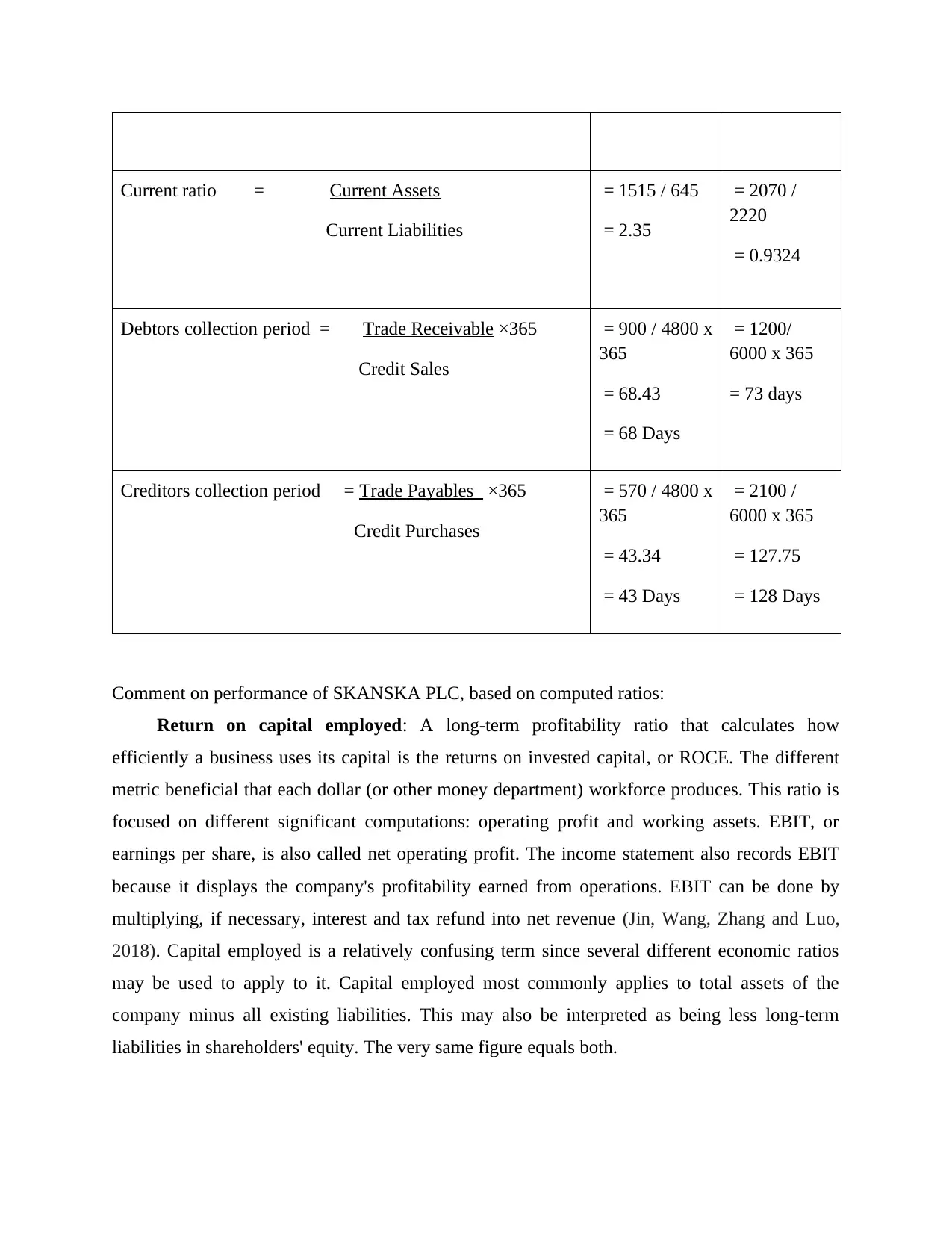
Current ratio = Current Assets
Current Liabilities
= 1515 / 645
= 2.35
= 2070 /
2220
= 0.9324
Debtors collection period = Trade Receivable ×365
Credit Sales
= 900 / 4800 x
365
= 68.43
= 68 Days
= 1200/
6000 x 365
= 73 days
Creditors collection period = Trade Payables ×365
Credit Purchases
= 570 / 4800 x
365
= 43.34
= 43 Days
= 2100 /
6000 x 365
= 127.75
= 128 Days
Comment on performance of SKANSKA PLC, based on computed ratios:
Return on capital employed: A long-term profitability ratio that calculates how
efficiently a business uses its capital is the returns on invested capital, or ROCE. The different
metric beneficial that each dollar (or other money department) workforce produces. This ratio is
focused on different significant computations: operating profit and working assets. EBIT, or
earnings per share, is also called net operating profit. The income statement also records EBIT
because it displays the company's profitability earned from operations. EBIT can be done by
multiplying, if necessary, interest and tax refund into net revenue (Jin, Wang, Zhang and Luo,
2018). Capital employed is a relatively confusing term since several different economic ratios
may be used to apply to it. Capital employed most commonly applies to total assets of the
company minus all existing liabilities. This may also be interpreted as being less long-term
liabilities in shareholders' equity. The very same figure equals both.
Current Liabilities
= 1515 / 645
= 2.35
= 2070 /
2220
= 0.9324
Debtors collection period = Trade Receivable ×365
Credit Sales
= 900 / 4800 x
365
= 68.43
= 68 Days
= 1200/
6000 x 365
= 73 days
Creditors collection period = Trade Payables ×365
Credit Purchases
= 570 / 4800 x
365
= 43.34
= 43 Days
= 2100 /
6000 x 365
= 127.75
= 128 Days
Comment on performance of SKANSKA PLC, based on computed ratios:
Return on capital employed: A long-term profitability ratio that calculates how
efficiently a business uses its capital is the returns on invested capital, or ROCE. The different
metric beneficial that each dollar (or other money department) workforce produces. This ratio is
focused on different significant computations: operating profit and working assets. EBIT, or
earnings per share, is also called net operating profit. The income statement also records EBIT
because it displays the company's profitability earned from operations. EBIT can be done by
multiplying, if necessary, interest and tax refund into net revenue (Jin, Wang, Zhang and Luo,
2018). Capital employed is a relatively confusing term since several different economic ratios
may be used to apply to it. Capital employed most commonly applies to total assets of the
company minus all existing liabilities. This may also be interpreted as being less long-term
liabilities in shareholders' equity. The very same figure equals both.
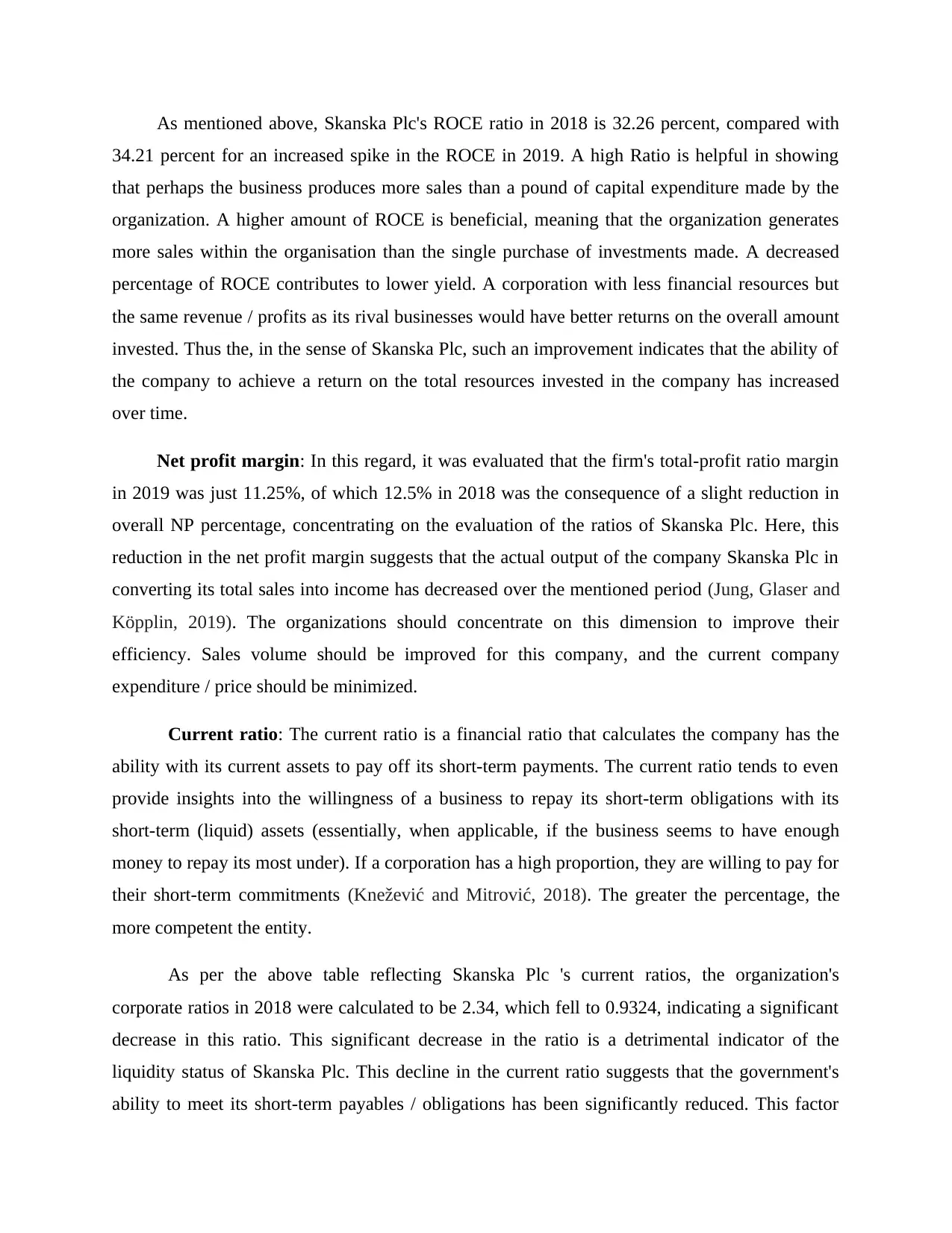
As mentioned above, Skanska Plc's ROCE ratio in 2018 is 32.26 percent, compared with
34.21 percent for an increased spike in the ROCE in 2019. A high Ratio is helpful in showing
that perhaps the business produces more sales than a pound of capital expenditure made by the
organization. A higher amount of ROCE is beneficial, meaning that the organization generates
more sales within the organisation than the single purchase of investments made. A decreased
percentage of ROCE contributes to lower yield. A corporation with less financial resources but
the same revenue / profits as its rival businesses would have better returns on the overall amount
invested. Thus the, in the sense of Skanska Plc, such an improvement indicates that the ability of
the company to achieve a return on the total resources invested in the company has increased
over time.
Net profit margin: In this regard, it was evaluated that the firm's total-profit ratio margin
in 2019 was just 11.25%, of which 12.5% in 2018 was the consequence of a slight reduction in
overall NP percentage, concentrating on the evaluation of the ratios of Skanska Plc. Here, this
reduction in the net profit margin suggests that the actual output of the company Skanska Plc in
converting its total sales into income has decreased over the mentioned period (Jung, Glaser and
Köpplin, 2019). The organizations should concentrate on this dimension to improve their
efficiency. Sales volume should be improved for this company, and the current company
expenditure / price should be minimized.
Current ratio: The current ratio is a financial ratio that calculates the company has the
ability with its current assets to pay off its short-term payments. The current ratio tends to even
provide insights into the willingness of a business to repay its short-term obligations with its
short-term (liquid) assets (essentially, when applicable, if the business seems to have enough
money to repay its most under). If a corporation has a high proportion, they are willing to pay for
their short-term commitments (Knežević and Mitrović, 2018). The greater the percentage, the
more competent the entity.
As per the above table reflecting Skanska Plc 's current ratios, the organization's
corporate ratios in 2018 were calculated to be 2.34, which fell to 0.9324, indicating a significant
decrease in this ratio. This significant decrease in the ratio is a detrimental indicator of the
liquidity status of Skanska Plc. This decline in the current ratio suggests that the government's
ability to meet its short-term payables / obligations has been significantly reduced. This factor
34.21 percent for an increased spike in the ROCE in 2019. A high Ratio is helpful in showing
that perhaps the business produces more sales than a pound of capital expenditure made by the
organization. A higher amount of ROCE is beneficial, meaning that the organization generates
more sales within the organisation than the single purchase of investments made. A decreased
percentage of ROCE contributes to lower yield. A corporation with less financial resources but
the same revenue / profits as its rival businesses would have better returns on the overall amount
invested. Thus the, in the sense of Skanska Plc, such an improvement indicates that the ability of
the company to achieve a return on the total resources invested in the company has increased
over time.
Net profit margin: In this regard, it was evaluated that the firm's total-profit ratio margin
in 2019 was just 11.25%, of which 12.5% in 2018 was the consequence of a slight reduction in
overall NP percentage, concentrating on the evaluation of the ratios of Skanska Plc. Here, this
reduction in the net profit margin suggests that the actual output of the company Skanska Plc in
converting its total sales into income has decreased over the mentioned period (Jung, Glaser and
Köpplin, 2019). The organizations should concentrate on this dimension to improve their
efficiency. Sales volume should be improved for this company, and the current company
expenditure / price should be minimized.
Current ratio: The current ratio is a financial ratio that calculates the company has the
ability with its current assets to pay off its short-term payments. The current ratio tends to even
provide insights into the willingness of a business to repay its short-term obligations with its
short-term (liquid) assets (essentially, when applicable, if the business seems to have enough
money to repay its most under). If a corporation has a high proportion, they are willing to pay for
their short-term commitments (Knežević and Mitrović, 2018). The greater the percentage, the
more competent the entity.
As per the above table reflecting Skanska Plc 's current ratios, the organization's
corporate ratios in 2018 were calculated to be 2.34, which fell to 0.9324, indicating a significant
decrease in this ratio. This significant decrease in the ratio is a detrimental indicator of the
liquidity status of Skanska Plc. This decline in the current ratio suggests that the government's
ability to meet its short-term payables / obligations has been significantly reduced. This factor
Secure Best Marks with AI Grader
Need help grading? Try our AI Grader for instant feedback on your assignments.
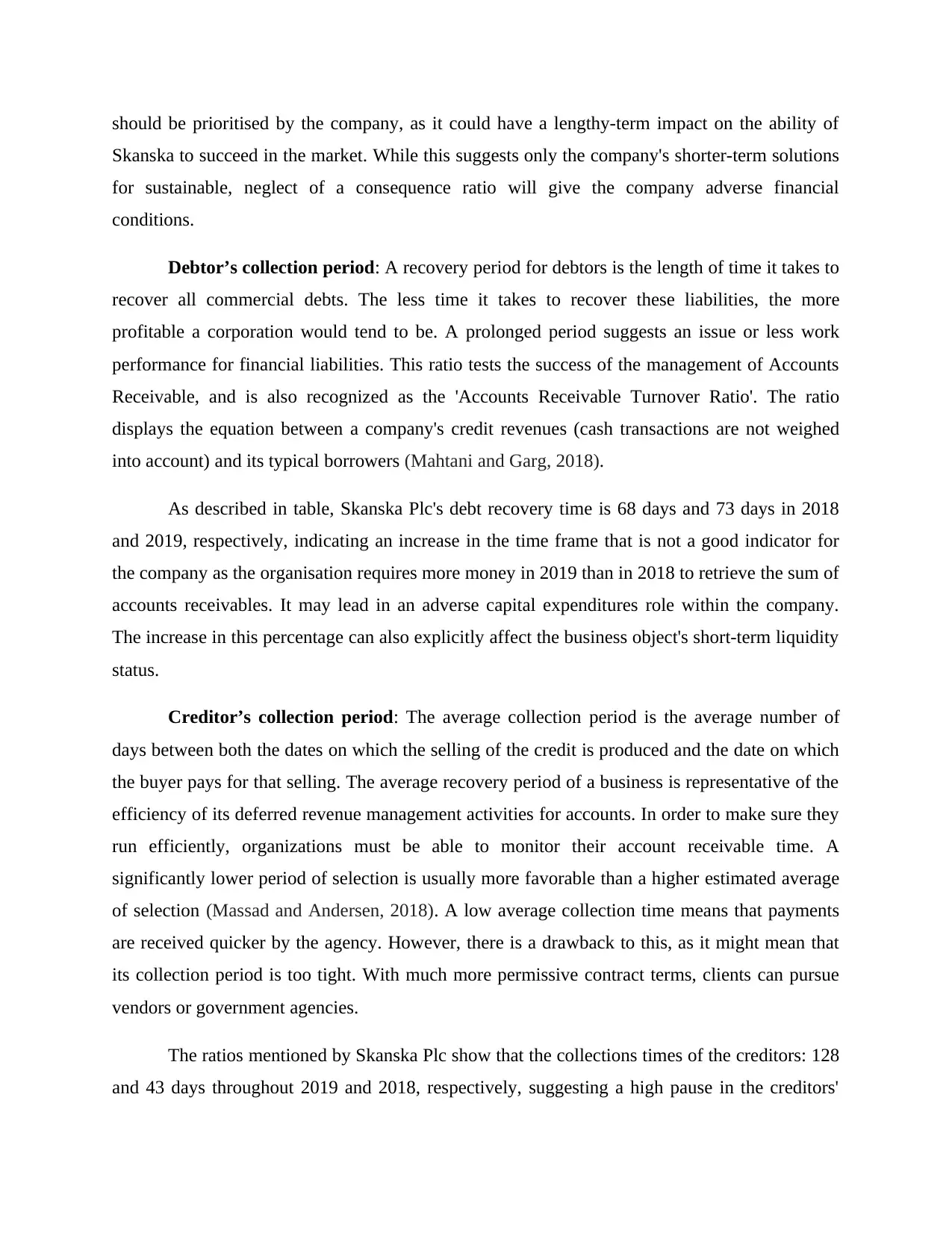
should be prioritised by the company, as it could have a lengthy-term impact on the ability of
Skanska to succeed in the market. While this suggests only the company's shorter-term solutions
for sustainable, neglect of a consequence ratio will give the company adverse financial
conditions.
Debtor’s collection period: A recovery period for debtors is the length of time it takes to
recover all commercial debts. The less time it takes to recover these liabilities, the more
profitable a corporation would tend to be. A prolonged period suggests an issue or less work
performance for financial liabilities. This ratio tests the success of the management of Accounts
Receivable, and is also recognized as the 'Accounts Receivable Turnover Ratio'. The ratio
displays the equation between a company's credit revenues (cash transactions are not weighed
into account) and its typical borrowers (Mahtani and Garg, 2018).
As described in table, Skanska Plc's debt recovery time is 68 days and 73 days in 2018
and 2019, respectively, indicating an increase in the time frame that is not a good indicator for
the company as the organisation requires more money in 2019 than in 2018 to retrieve the sum of
accounts receivables. It may lead in an adverse capital expenditures role within the company.
The increase in this percentage can also explicitly affect the business object's short-term liquidity
status.
Creditor’s collection period: The average collection period is the average number of
days between both the dates on which the selling of the credit is produced and the date on which
the buyer pays for that selling. The average recovery period of a business is representative of the
efficiency of its deferred revenue management activities for accounts. In order to make sure they
run efficiently, organizations must be able to monitor their account receivable time. A
significantly lower period of selection is usually more favorable than a higher estimated average
of selection (Massad and Andersen, 2018). A low average collection time means that payments
are received quicker by the agency. However, there is a drawback to this, as it might mean that
its collection period is too tight. With much more permissive contract terms, clients can pursue
vendors or government agencies.
The ratios mentioned by Skanska Plc show that the collections times of the creditors: 128
and 43 days throughout 2019 and 2018, respectively, suggesting a high pause in the creditors'
Skanska to succeed in the market. While this suggests only the company's shorter-term solutions
for sustainable, neglect of a consequence ratio will give the company adverse financial
conditions.
Debtor’s collection period: A recovery period for debtors is the length of time it takes to
recover all commercial debts. The less time it takes to recover these liabilities, the more
profitable a corporation would tend to be. A prolonged period suggests an issue or less work
performance for financial liabilities. This ratio tests the success of the management of Accounts
Receivable, and is also recognized as the 'Accounts Receivable Turnover Ratio'. The ratio
displays the equation between a company's credit revenues (cash transactions are not weighed
into account) and its typical borrowers (Mahtani and Garg, 2018).
As described in table, Skanska Plc's debt recovery time is 68 days and 73 days in 2018
and 2019, respectively, indicating an increase in the time frame that is not a good indicator for
the company as the organisation requires more money in 2019 than in 2018 to retrieve the sum of
accounts receivables. It may lead in an adverse capital expenditures role within the company.
The increase in this percentage can also explicitly affect the business object's short-term liquidity
status.
Creditor’s collection period: The average collection period is the average number of
days between both the dates on which the selling of the credit is produced and the date on which
the buyer pays for that selling. The average recovery period of a business is representative of the
efficiency of its deferred revenue management activities for accounts. In order to make sure they
run efficiently, organizations must be able to monitor their account receivable time. A
significantly lower period of selection is usually more favorable than a higher estimated average
of selection (Massad and Andersen, 2018). A low average collection time means that payments
are received quicker by the agency. However, there is a drawback to this, as it might mean that
its collection period is too tight. With much more permissive contract terms, clients can pursue
vendors or government agencies.
The ratios mentioned by Skanska Plc show that the collections times of the creditors: 128
and 43 days throughout 2019 and 2018, respectively, suggesting a high pause in the creditors'
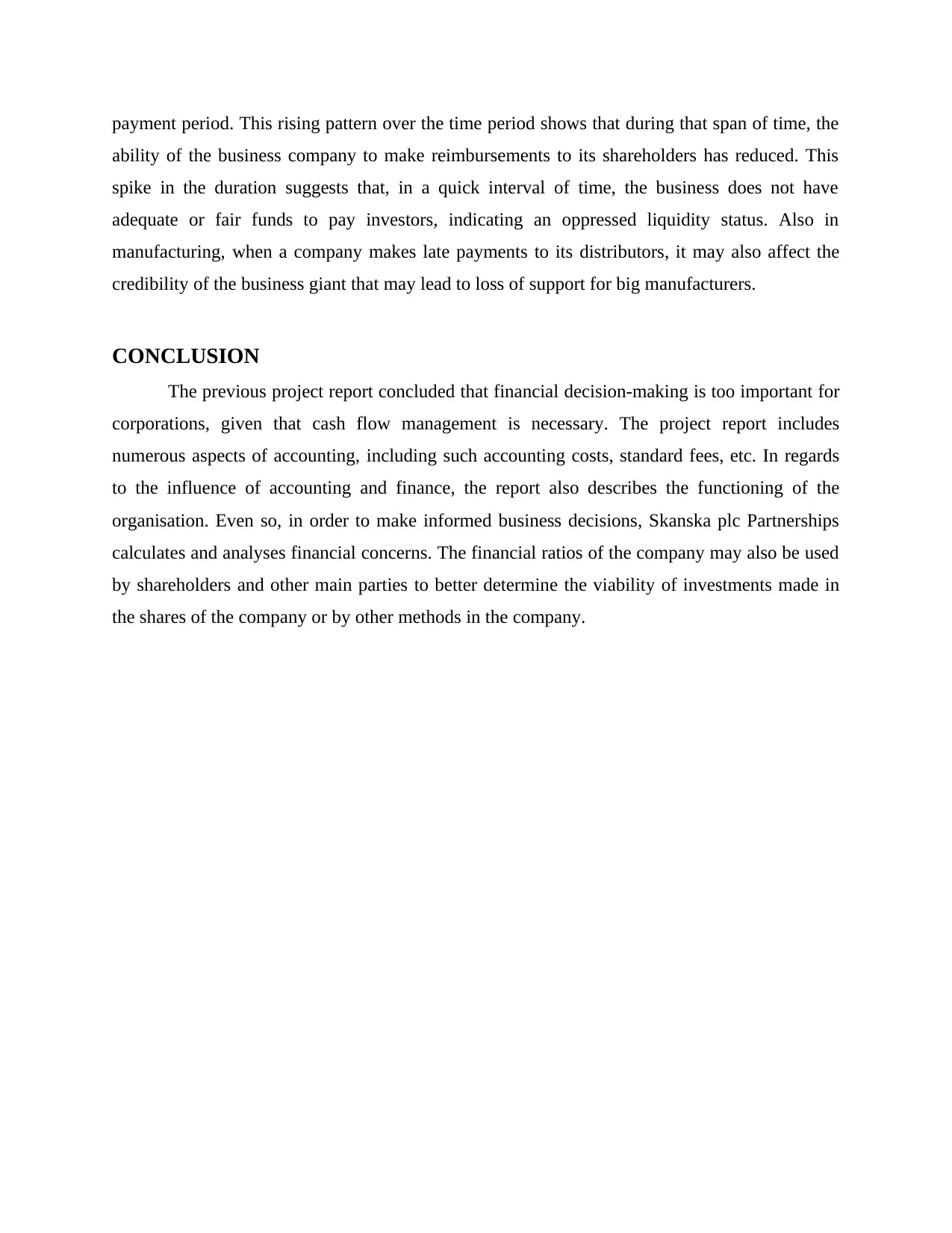
payment period. This rising pattern over the time period shows that during that span of time, the
ability of the business company to make reimbursements to its shareholders has reduced. This
spike in the duration suggests that, in a quick interval of time, the business does not have
adequate or fair funds to pay investors, indicating an oppressed liquidity status. Also in
manufacturing, when a company makes late payments to its distributors, it may also affect the
credibility of the business giant that may lead to loss of support for big manufacturers.
CONCLUSION
The previous project report concluded that financial decision-making is too important for
corporations, given that cash flow management is necessary. The project report includes
numerous aspects of accounting, including such accounting costs, standard fees, etc. In regards
to the influence of accounting and finance, the report also describes the functioning of the
organisation. Even so, in order to make informed business decisions, Skanska plc Partnerships
calculates and analyses financial concerns. The financial ratios of the company may also be used
by shareholders and other main parties to better determine the viability of investments made in
the shares of the company or by other methods in the company.
ability of the business company to make reimbursements to its shareholders has reduced. This
spike in the duration suggests that, in a quick interval of time, the business does not have
adequate or fair funds to pay investors, indicating an oppressed liquidity status. Also in
manufacturing, when a company makes late payments to its distributors, it may also affect the
credibility of the business giant that may lead to loss of support for big manufacturers.
CONCLUSION
The previous project report concluded that financial decision-making is too important for
corporations, given that cash flow management is necessary. The project report includes
numerous aspects of accounting, including such accounting costs, standard fees, etc. In regards
to the influence of accounting and finance, the report also describes the functioning of the
organisation. Even so, in order to make informed business decisions, Skanska plc Partnerships
calculates and analyses financial concerns. The financial ratios of the company may also be used
by shareholders and other main parties to better determine the viability of investments made in
the shares of the company or by other methods in the company.
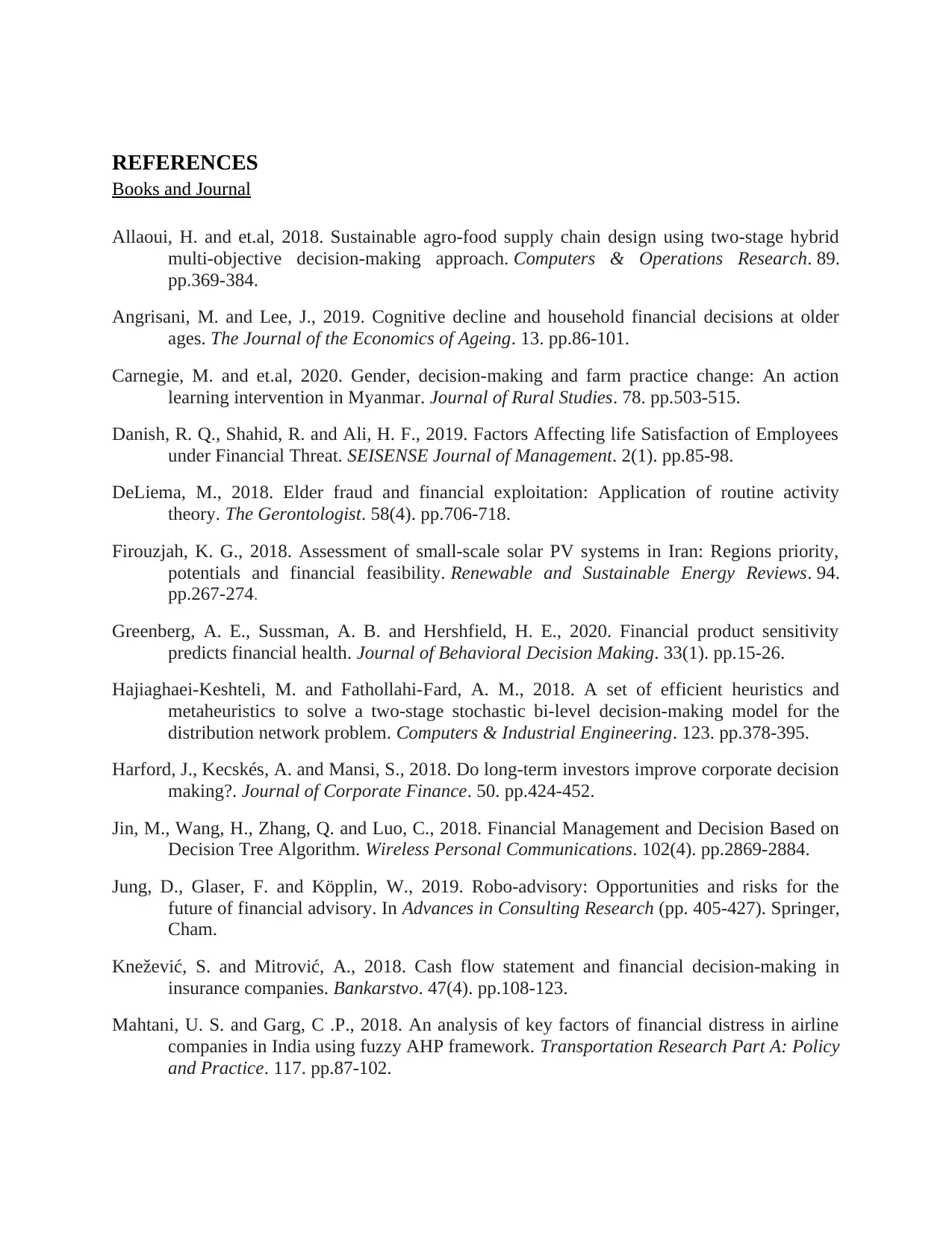
REFERENCES
Books and Journal
Allaoui, H. and et.al, 2018. Sustainable agro-food supply chain design using two-stage hybrid
multi-objective decision-making approach. Computers & Operations Research. 89.
pp.369-384.
Angrisani, M. and Lee, J., 2019. Cognitive decline and household financial decisions at older
ages. The Journal of the Economics of Ageing. 13. pp.86-101.
Carnegie, M. and et.al, 2020. Gender, decision-making and farm practice change: An action
learning intervention in Myanmar. Journal of Rural Studies. 78. pp.503-515.
Danish, R. Q., Shahid, R. and Ali, H. F., 2019. Factors Affecting life Satisfaction of Employees
under Financial Threat. SEISENSE Journal of Management. 2(1). pp.85-98.
DeLiema, M., 2018. Elder fraud and financial exploitation: Application of routine activity
theory. The Gerontologist. 58(4). pp.706-718.
Firouzjah, K. G., 2018. Assessment of small-scale solar PV systems in Iran: Regions priority,
potentials and financial feasibility. Renewable and Sustainable Energy Reviews. 94.
pp.267-274.
Greenberg, A. E., Sussman, A. B. and Hershfield, H. E., 2020. Financial product sensitivity
predicts financial health. Journal of Behavioral Decision Making. 33(1). pp.15-26.
Hajiaghaei-Keshteli, M. and Fathollahi-Fard, A. M., 2018. A set of efficient heuristics and
metaheuristics to solve a two-stage stochastic bi-level decision-making model for the
distribution network problem. Computers & Industrial Engineering. 123. pp.378-395.
Harford, J., Kecskés, A. and Mansi, S., 2018. Do long-term investors improve corporate decision
making?. Journal of Corporate Finance. 50. pp.424-452.
Jin, M., Wang, H., Zhang, Q. and Luo, C., 2018. Financial Management and Decision Based on
Decision Tree Algorithm. Wireless Personal Communications. 102(4). pp.2869-2884.
Jung, D., Glaser, F. and Köpplin, W., 2019. Robo-advisory: Opportunities and risks for the
future of financial advisory. In Advances in Consulting Research (pp. 405-427). Springer,
Cham.
Knežević, S. and Mitrović, A., 2018. Cash flow statement and financial decision-making in
insurance companies. Bankarstvo. 47(4). pp.108-123.
Mahtani, U. S. and Garg, C .P., 2018. An analysis of key factors of financial distress in airline
companies in India using fuzzy AHP framework. Transportation Research Part A: Policy
and Practice. 117. pp.87-102.
Books and Journal
Allaoui, H. and et.al, 2018. Sustainable agro-food supply chain design using two-stage hybrid
multi-objective decision-making approach. Computers & Operations Research. 89.
pp.369-384.
Angrisani, M. and Lee, J., 2019. Cognitive decline and household financial decisions at older
ages. The Journal of the Economics of Ageing. 13. pp.86-101.
Carnegie, M. and et.al, 2020. Gender, decision-making and farm practice change: An action
learning intervention in Myanmar. Journal of Rural Studies. 78. pp.503-515.
Danish, R. Q., Shahid, R. and Ali, H. F., 2019. Factors Affecting life Satisfaction of Employees
under Financial Threat. SEISENSE Journal of Management. 2(1). pp.85-98.
DeLiema, M., 2018. Elder fraud and financial exploitation: Application of routine activity
theory. The Gerontologist. 58(4). pp.706-718.
Firouzjah, K. G., 2018. Assessment of small-scale solar PV systems in Iran: Regions priority,
potentials and financial feasibility. Renewable and Sustainable Energy Reviews. 94.
pp.267-274.
Greenberg, A. E., Sussman, A. B. and Hershfield, H. E., 2020. Financial product sensitivity
predicts financial health. Journal of Behavioral Decision Making. 33(1). pp.15-26.
Hajiaghaei-Keshteli, M. and Fathollahi-Fard, A. M., 2018. A set of efficient heuristics and
metaheuristics to solve a two-stage stochastic bi-level decision-making model for the
distribution network problem. Computers & Industrial Engineering. 123. pp.378-395.
Harford, J., Kecskés, A. and Mansi, S., 2018. Do long-term investors improve corporate decision
making?. Journal of Corporate Finance. 50. pp.424-452.
Jin, M., Wang, H., Zhang, Q. and Luo, C., 2018. Financial Management and Decision Based on
Decision Tree Algorithm. Wireless Personal Communications. 102(4). pp.2869-2884.
Jung, D., Glaser, F. and Köpplin, W., 2019. Robo-advisory: Opportunities and risks for the
future of financial advisory. In Advances in Consulting Research (pp. 405-427). Springer,
Cham.
Knežević, S. and Mitrović, A., 2018. Cash flow statement and financial decision-making in
insurance companies. Bankarstvo. 47(4). pp.108-123.
Mahtani, U. S. and Garg, C .P., 2018. An analysis of key factors of financial distress in airline
companies in India using fuzzy AHP framework. Transportation Research Part A: Policy
and Practice. 117. pp.87-102.
Paraphrase This Document
Need a fresh take? Get an instant paraphrase of this document with our AI Paraphraser
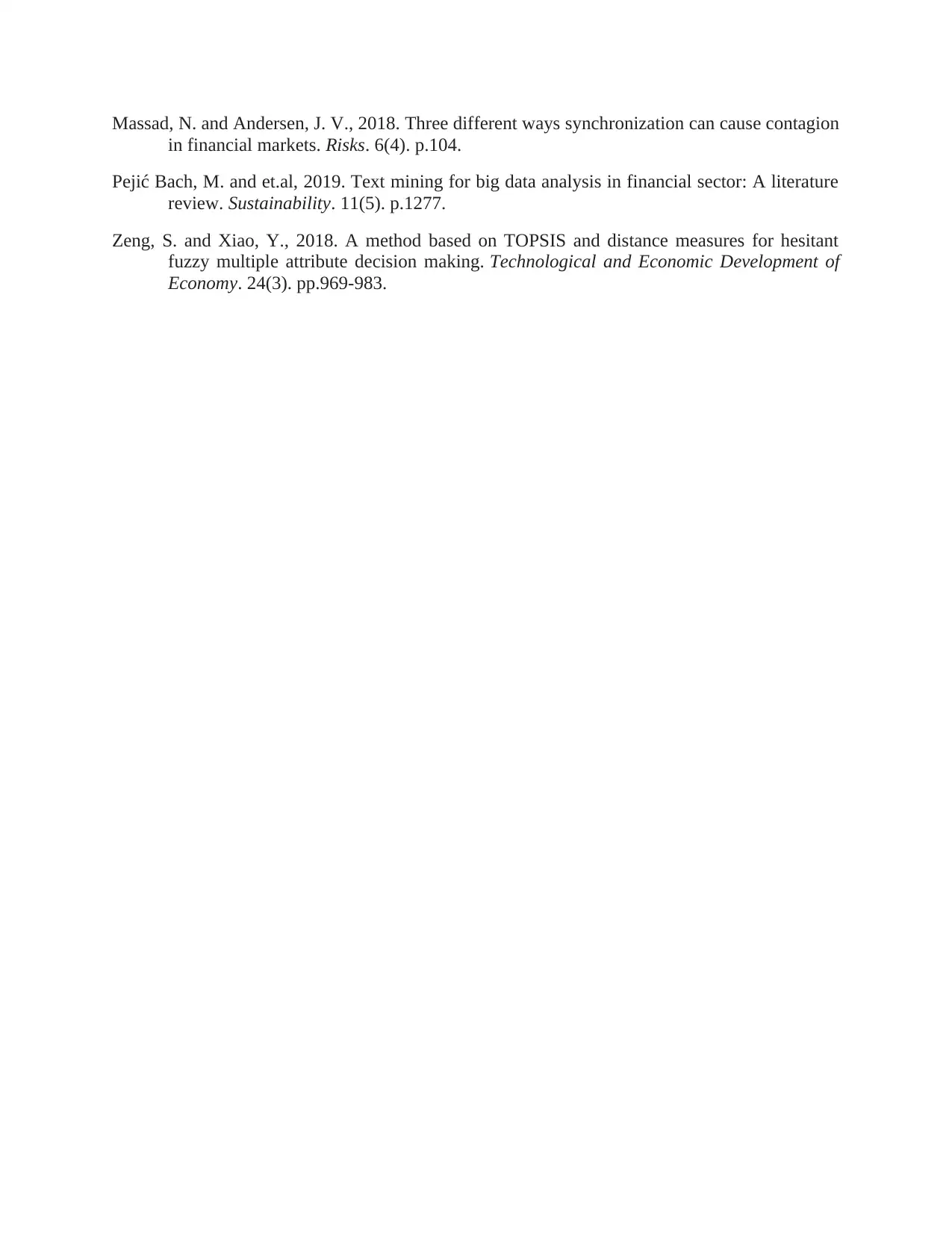
Massad, N. and Andersen, J. V., 2018. Three different ways synchronization can cause contagion
in financial markets. Risks. 6(4). p.104.
Pejić Bach, M. and et.al, 2019. Text mining for big data analysis in financial sector: A literature
review. Sustainability. 11(5). p.1277.
Zeng, S. and Xiao, Y., 2018. A method based on TOPSIS and distance measures for hesitant
fuzzy multiple attribute decision making. Technological and Economic Development of
Economy. 24(3). pp.969-983.
in financial markets. Risks. 6(4). p.104.
Pejić Bach, M. and et.al, 2019. Text mining for big data analysis in financial sector: A literature
review. Sustainability. 11(5). p.1277.
Zeng, S. and Xiao, Y., 2018. A method based on TOPSIS and distance measures for hesitant
fuzzy multiple attribute decision making. Technological and Economic Development of
Economy. 24(3). pp.969-983.
1 out of 14
Your All-in-One AI-Powered Toolkit for Academic Success.
+13062052269
info@desklib.com
Available 24*7 on WhatsApp / Email
![[object Object]](/_next/static/media/star-bottom.7253800d.svg)
Unlock your academic potential
© 2024 | Zucol Services PVT LTD | All rights reserved.




